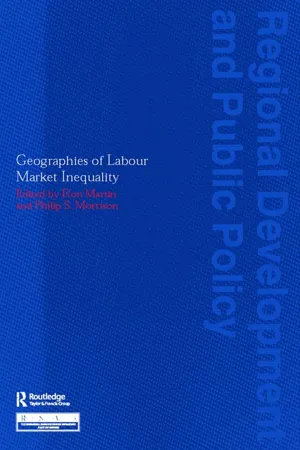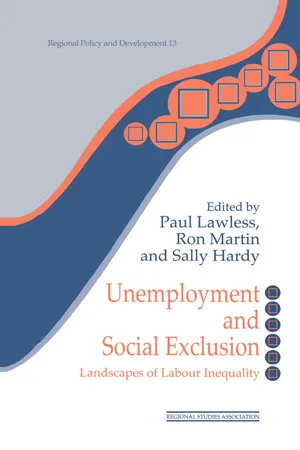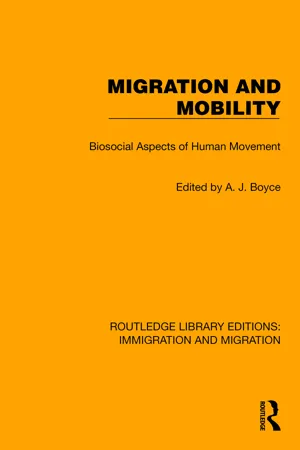Geography
Employment
Employment refers to the state of having a paid job or being engaged in work for a wage or salary. It is a crucial aspect of economic development and is influenced by various factors such as education, skills, and location. In Geography, the study of employment patterns and trends can provide insights into the social and economic dynamics of a region.
Written by Perlego with AI-assistance
Related key terms
3 Key excerpts on "Employment"
- eBook - ePub
- Ron Martin, Philip S. Morrison(Authors)
- 2003(Publication Date)
- Routledge(Publisher)
Introduction
Passage contains an image
1 Thinking about the geographies of labour
Ron Martin and Philip S. MorrisonThe new focus on labour geographies
Over the past decade, the geography of the labour market has received increasing attention from both academic analysts and policy-makers alike. In economic geography, for example, research into labour and labour markets has been growing apace (for example, Allen and Henry, 1997; Hanson and Pratt, 1992, 1995; Clark, 1989; Herod, 1995, 1997; Lawless et al., 1998; McDowell, 1997; Martin, 1986; 2000; Martin et al., 1996; Morrison, 1990; Peck, 1989, 1992, 1996; Regional Studies, 1996). Basic to this new-found focus is the belief that the labour market has an intrinsically local or spatially constituted level of operation and regulation, that the creation and destruction of jobs, and the processes of Employment, unEmployment and wage setting, and the institutional and social regulation of these processes, are, to some extent at least, geographically constituted. It is within specific spatial settings and contexts – local and regional labour markets – that workers seek Employment and employers hire and fire workers, that particular forms of Employment structures evolve, that specific Employment practices, work cultures and labour relations become established, and particular institutionalised modes of labour regulation emerge or are imposed. While it would certainly be an exaggeration to claim that this growing literature constitutes a fully articulated spatial theory of labour markets, the topic is at last firmly established as a key subject of geographical enquiry.At the same time, economists have also discovered geography in their theorisations and analyses of the labour market. Historically, economists have not assigned much significance to the geography of the labour market (see the critique by Corina, 1972). Even in the work of the most influential labour economists, the labour market was a curiously spaceless entity, either a purely abstract (micro-economic) construct or a macro-economic aggregate. In the main, the role of location in the functioning and operation of labour market processes tended to be viewed as secondary, and was used either as a means of introducing barriers, such as incomplete information or incomplete mobility, into the free functioning of market (Rees and Schultz, 1970; Robinson, 1970), or as a way of identifying those markets experiencing different Employment conditions (for example, Mackay et al., 1971). However, at least two recent texts in labour economics have begun to recognise the geography inherent in labour markets (see, for example, Bosworth et al - eBook - ePub
Unemployment and Social Exclusion
Landscapes of Labour inequality and Social Exclusion
- Sally Hardy, Paul Lawless, Ron Martin(Authors)
- 2013(Publication Date)
- Routledge(Publisher)
where they are drawn, have an impact on the picture of unEmployment or non-Employment that is obtained. The use of more than one areal framework in the analyses below permits a variety of perspectives and enables insights into confirmatory or contradictory patterns of spatial variation at different geographical scales. However, it should be borne in mind that the interpretation of indicators may vary at different spatial scales.Key Features of Continuity and Change in the Geography of UnEmployment and Non-Employment
‘Explaining' changes in the spatial distribution of unEmployment and non-Employment
Changes in unEmployment may arise for a number of different reasons, since unEmployment is a function of the interaction of changes in labour supply and labour demand (see Beatty and Fothergill 1994 ; Green and Owen 1991 ). In simplistic terms, unEmployment increases may occur in the face of Employment growth if growth in the population seeking work (as a result of natural change, in-migration or participation increase) outstrips the increase in jobs available, as well as in circumstances of Employment decline (when labour supply reductions through out-migration and withdrawal from the labour force are outstripped by job losses). Hence in attempting to ‘explain’ unEmployment changes in different areas, it is important to bear in mind how supply and demand factors interact in different ways in different areas to produce such changes.Application of a labour market accounts methodology to local labour market areas shows that some large cities (such as Liverpool) would have had a higher unEmployment rate if it were not for net out-migration, while in some towns (such as Milton Keynes) net in-migration and natural increases have been key factors in increasing the unEmployment rate despite the expansion of Employment opportunities. Similarly, research on recent changes in Employment and unEmployment in coal-mining communities reveals that in the face of the demise of jobs in mining and related industries, many working age adults withdrew’ from the labour force (that is, became inactive) rather than becoming unemployed (Beatty and Fothergill 1994 ; see also Chapter 5 - eBook - ePub
Migration and Mobility
Biosocial Aspects of Human Movement
- A.J. Boyce(Author)
- 2022(Publication Date)
- Routledge(Publisher)
It is likely, too, that new jobs in manufacturing will be seen as being much less footloose than was thought to be the the case in the past, since in a world competing for jobs, any external economies that can be derived in the economically more attractive locations in Britain may have to be cherished. Hence, there are likely to be greater reservations about relocating jobs from areas of Employment surplus to areas of higher unEmployment; and labour migration may be required to take a more direct role as a positive instrument in planning policy, since the redistribution of population to take advantage of any available Employment opportunities could be of growing importance (Johnson & Salt 1980a). LOCAL LABOUR MARKETS AND MIGRATION Although it is reasonable to assume that much inter-urban migration is accounted for by labour migration, there are important problems involved in the definition of appropriate geographical areas to study its incidence. In reality, what is involved is not population movement among clearly defined urban settlements, but among much vaguer local labour markets. The overall labour market of any country consists of a complex grouping of sub-markets, each centred on a local concentration of jobs. When the idea of a local labour market is translated into real geographical terms it simply implies the area around an Employment centre (usually an individual town or city) in which competition for labour normally takes place. Around such an Employment centre there will also be an aggregate housing market in which local employees compete for accommodation. At a general level, the local housing and the local labour markets will be similar in extent, with daily journeys to work binding places of residence to places of Employment (Johnson et al. 1974a). Unfortunately there are practical and theoretical problems in converting this simple idea into a practical operational tool
Index pages curate the most relevant extracts from our library of academic textbooks. They’ve been created using an in-house natural language model (NLM), each adding context and meaning to key research topics.


